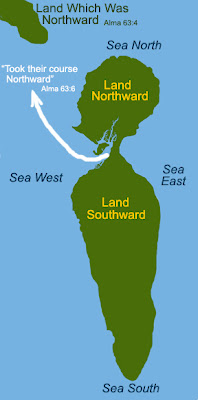1. How many emigrants went north in Hagoth’s ships?
2. Where did Hagoth's immigrants land and why were they never heard from again?
3. Why did no one know where these first immigrants went when the first ship returned for a second group of immigrants?
4. Did Hagoth's immigrants land in the same vicinity that those who traveled by land, mentioned in Helaman 3:3-4, reach?
5. When the immigrants mentioned in Helaman 3:3-4 settled the Old Jaredite domain of many waters and rivers just eight years after Hagoth's ships sailed, then spread out over the entire land from the north sea to the south, from the east sea to the west, why did they not encounter Hagoth's immigrants?
6. When Mormon led his people in a retreat from Zarahemla to the area of many waters and rivers in the land northward around 385 A.D., why did they not seek aid from the Nephite descendants of Hagoth's immigrants (who had settled somewhere to the north) in the great and final battle with the Lamanites?
7. If Hagoth's ships with their thousands of immigrants went north beyond the Old Jaredite Land Northward, where is the evidence of Nephite culture to the north of the Land of Promise?
In this post and the next few, we will take a look at and answer each of these questions:
1. How many emigrants went north in Hagoth’s ships?
Mormon tells us as an introduction to the building and sailing of Hagoth’s ships, that in the year they were built, 5,400 men, plus women and children, went northward (Alma 63:4). If we take 5,400 men and add a like number of wives, we have 10,800 people. If they had 2 children each, there would be 21,600 people. If each couple had an average of three children, there would be 27,000 people. Thus, somewhere between 20,000 and 25,000 people are described as going north in Hagoth’s ships. After describing this ship movement, Mormon then writes about those who went overland into the Land Northward (Alma 63:9). About ten years later, in Helaman, Mormon again mentions those who went overland into the Land Northward (Helaman 3:3). Thus, we can see that these were two entirely different movements—one by ship, and one by land.
2. Where did Hagoth's immigrants land and why were they never heard from again?
 Mormon tells us they went to “a land which was northward” (see last post), which describes a place not connected to the Land Northward. And since at this time the Land of Promise was an island (2 Nephi 10:20), the land “which was northward” would have been across an open sea to some land beyond the Land Northward. This location is the subject of the next post.
Mormon tells us they went to “a land which was northward” (see last post), which describes a place not connected to the Land Northward. And since at this time the Land of Promise was an island (2 Nephi 10:20), the land “which was northward” would have been across an open sea to some land beyond the Land Northward. This location is the subject of the next post.3. Why did no one know where these first immigrants went when the first ship returned for a second group of immigrants?
Mormon writes that in the second year, the first ship Hagoth built that went northward returned while he was busy building another ship (Alma 63:8). Obviously, this ship deposited all their emigrants and returned. Evidently, another large number boarded the ship, which again took its journey northward (Alma 63:7). Therefore, other than the crew which returned on the ship, no one would have known exactly where it went—and if the ship went into unknown waters to the north and landed along the shore of an unknown and nameless land there, no one returning on the ship could have specifically said where they went except “to a land which was northward.” That this land would have had no name is obvious.
The entire land making up the Land of Promise given to Lehi, and the Land Northward, given to the Jaredites, is never recorded as having a name other than the Land of Promise or the promised land. When Columbus discovered the islands in the Caribbean Sea on his first two voyages, and then the area of lower Central America and the northeast corner of South America, none of these lands had names—other than the names given them by Columbus, which were often changed by others who settled the lands much later. Based upon much later writers of the 16th century, including Ixtlilxochitl, the emigrants landing in Hagoth’s ships in the land which was northward, eventually called the land Bountiful, after the land from which they sailed. But at the time of Mormon’s writing, these lands had no name, and could be referred to by the sailors who made at least one round trip, as the land which was northward—the term Mormon used to describe their journey. Then, too, because there was no future intercourse between these 20,000 to 25,000 emigrants into that far off land and those in the Land of Promise, Mormon’s only other conclusion was that maybe they had perished and went down at sea (Alma 63:8).
(See the next post, “What the Story of Hagoth Tells Us – Part IV,” for more information in answering these questions about Hagoth and his ships and emigrants)




No comments:
Post a Comment